|
FAQs about Stony Coral, Cnidarian
Identification 6
Related FAQs: Stony Coral ID 1, Stony Coral ID 2, Stony Coral ID
3, Stony
Coral ID 4, Stony Coral ID 5,
Stony Coral ID 7, Stony Coral ID 8, Stony Coral ID 9, Stony Coral ID 10, Stony Coral ID 12, Stony Coral ID 13, Stony Coral ID 14, Stony Coral ID 15, & Cnidarian
Identification, Stony FAQs 1, Stony
FAQs 2, Foods/Feeding/Nutrition, Disease/Health, Propagation, Coral Compatibility, Stony Coral Behavior,
Related Articles: Stony
Corals,
|
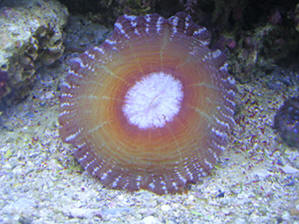
|
|
ID help -- 02/07/08 I recently picked a new
piece of coral up. It is unlike anything I have ever seen. Here
is a link to a thread with some pretty good pictures that I took
of the coral. Please let me know what it is.
http://www.reefcentral.com/forums/showthread.php?s=&threadid=1312909
<Wow, that's a tough one. The tissue makes it pretty hard
to see the skeleton. My best guess is some kind of Goniopora sp.
but I honestly can't be sure. Are there any dead, exposed
parts of the skeleton you could take a picture of? If you could
send that in, it would really help. Or maybe Bob has a better
idea. If all else fails, you can always ask Eric B. Though
I'm sure he'll likely also ask you for pics of the
exposed skeleton for any proper ID.> Thanks Ian Iwane <De
nada, Sara M.>
Re: Scler. ID help 2/8/08 Thanks
Sara, There is no exposed skeleton on the piece. I was thinking
last thing I would try to do is cut a little piece off and bleach
it. If that was necessary. For a size scale, each polyp is around
2mm or so. Let me know if you guys have any other ideas.
<Well, Bob doesn't think it's Goniopora, so I'm
out of ideas right now. Having a clean piece of skeleton would
certainly help if you think you can spare it.> Thanks Ian
<Best, Sara M.> <<We'll see... RMF>>
|
|
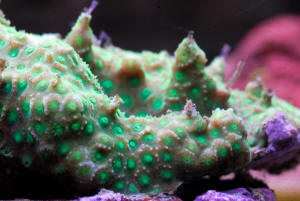 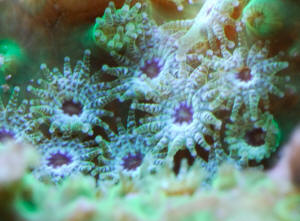 Mmm... no... RMF Mmm... no... RMF
Re: ID help- Madracis sp? 02/19/2008 I
updated a skeleton shot in the same thread. Take a look at it
tell me if it helps
http://www.reefcentral.com/forums/showthread.php?s=&threadid=1312909&perpage=25&pagenumber=2
<So sorry for the very, very delayed response. I was out
of the country. The skeleton pics are very helpful, thank
you. There's still too much tissue/water on it, such that
the details/nuances are obscured. However, I can see enough
to see why someone posted that it looks like it could be
Madracis pharensis. I do agree it looks like a Madracis sp.
However, I think it's more likely Madracis kirbyi. I say
this because Madracis pharensis is not found in the
Indo-Pacific (where most all our corals in the trade are
from). Madracis kirbyi is found in the Indo-Pacific (one of
the few Madracis sp. which are).> Ian
<Best,
Sara M.> |
|
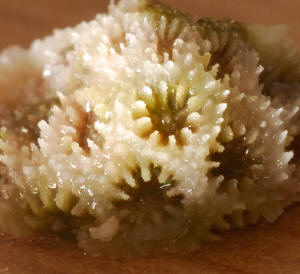
|
Re: ID help -02/20/08 I attached
a new skeletal shot. The skeleton looks nothing like
the kirbyi. I guess they have said that the pharensis
has been found along the pacific coast of Mexico.
Also my friend Norman (Mr.. ugly on RC) said that he
read somewhere that it was also found in Hawaii. Not
sure though. Take a look at the new shot at tell me
what you think. <Ok, yes, that photo is more
clear... but I still couldn't tell you for sure
if it's M. pharensis or M. kirbyi. The two are
just so similar. One would almost have to look under
a microscope to tell them apart. You might want to
ask Eric B. However, again, it just seems SO odd that
a M. pharensis (which, according to Veron, is
"rare except in caves") coral would end up
in a US LFS. And the book doesn't include Hawaii
or Mexico in its range. But even if it's true
that a M. pharensis could be found in Hawaii or
Mexico, that would still be rather unusual since
we're not meant to get corals from these places.
But maybe Bob has more insight into
this.><<Mmm, no... not w/o more delving than
I have resource for currently. RMF>> Ian
<Thanks for Sara M.>
|
|
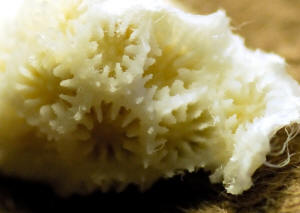
|
|
|
| Tiger Jawfish Keeps laying eggs, and unidentified
coral 01/28/2008 Hi all, <<Hello, Andrew today>>
It's been a while since I wrote last. I have a 95 wave tank
with 48" metal halides (by orbit) it's also got actinics
and moonlights. Everything is on a timer. I do regular water
changes, about 10-20% every week. I supplement the tank with the
following; Essential Elements (5 ml/week) Liquid Calcium (2
tsp/day) Microvert (5 tsp/week) Tech M (20 ml/week) Phytoplankton
(10-15 ml/week) <<Sounds good>> About a year ago I
purchased two Tiger Jawfish about two months apart. Initially they
had a couple spats but got over themselves. After I moved and
re-arranged the tank they started living with each other. Now the
female stays plump and the male has a new batch of eggs in his
mouth every couple of weeks. I have a brine shrimp tank where I
hatch them but I haven't seen any baby jaws to feed. I use a
turkey baster to feed my corals, I used that to spray some of the
hatched brine shrimp into the Jawfish den. It's been about 3
months since it's started and I was hoping you had some advice
about raising them. I'm moving in the next month so I don't
have a lot of time. I doubt they'll start breeding again after
I move. <<Your best bet to attempt to raise them is to move
them to a separate aquarium as they will more than likely become a
nice meal for other inhabitants>> I was also wondering what
this coral is (only photo of just a coral attached) It's about
the size of a volley ball and it seems happiest about a foot from
the top of the tank. <<The coral is a Favites SP closed brain
LPS coral. Looks bleached with a severe loss of colour. Please read
more here http://www.wetwebmedia.com/faviidae2.htm >> If I
need to list what's in my tank I can. I included a couple
photos of where the Jawfish den is (just under the rose anemone)
Thanks ahead of time! Matt <<Thanks for the questions. A
Nixon>> |
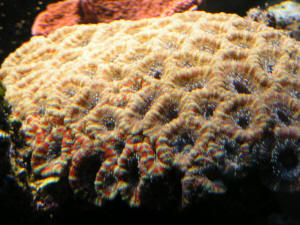 |
|
|

